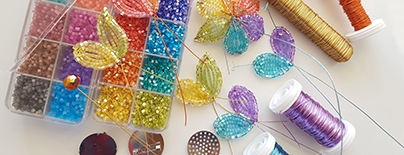The rainbow brooch is made using the French beading technique, i.e. plaiting around the axis.
This technique is best suited to the creation of flower petals and leaves. Two textures of two-cut beads of one shade are used on each petal and a leaf. The two-cut beads are the dominant seed beads, while the triangles are secondary; they decorate the flower and give it its final appearance.
Svetlana Sapegina is a famous Russian bead artist, teacher and exhibitor with many years of experience.
Learn MoreAn orange, yellow, blue 0.5 mm diameter wire; a brooch base or a ring with a perforated circumference; a standard set of tools: snipping pliers, flat nose pliers, needle nose pliers.

Share this project with your friends
This website is using cookies
To improve our services and provide information that suits your interest, we use the advanced website traffic analytics tools. However, we need your consent. More information about how we process and protect your data can be found in the privacy statement. We ask you for approval of the terms.